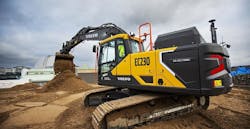Volvo CE Posts 26.5-Percent Fourth Quarter Net Sales Hike
Volvo Construction Equipment posted SEK 27,596 million in revenue in the fourth quarter of 2021 compared to SEK 21,812 million in the fourth quarter of 2021, a 26.5-percent jump. North America sales were SEK 6,294 million compared to SEK 4,077 in the fourth quarter of 2021, a 54.3-percent hike, thanks to strong activity in the infrastructure segment. China, which has continued to be impacted by low economic activity last year during the Covid-19 pandemic and ongoing lockdowns, reported an increase in sales and deliveries in the fourth quarter because of the introduction of emissions regulations.
For Asia overall, Volvo posted SEK 9,896 million compared to SEK 7,269 a year ago, a 36.1-percent increase. Sales in Europe grew slightly from SEK 7,631 million in the year-ago quarter to SEK 7,878 in the recently concluded frame, a 3.2-percent incline. South America enjoyed a 31.3-percent net sales hike, while Africa & Oceania posted a 19.9-percent fourth quarter net sales increase.
For the full year, Volvo CE topped SEK 100 million with SEK 100,261 compared to SEK 92,031, an 8.9-percent leap. For North America, net sales were SEK 22,294 million compared to SEK 16,583 a year ago, a 34.4-percent leap. In Asia for the full year net sales dropped 6 percent. Europe enjoyed a modest 2.2-percent sales rise. South America posted SEK 6,491 million compared to SEK 3,951 million for a 64.3-percent year-over-year leap. Net sales in Africa and Oceania were a 27.2-percent hike.
In the fourth quarter, machine sales and the service market contributed to increased revenues. Global net order intake continued to be low with a 23-percent year-over-year decline in the fourth quarter, although orders increased slightly compared to the third quarter, largely because of restrictive order slotting caused by large order books and long lead times in North America and Europe, as well as stopped sales in Russia. However, deliveries increased by 4 percent, thanks to strong demand in North America and Asia and thanks to emission regulations in China and strong demand inNorth America and Asia.
Volvo CE continued to innovate with the introduction of automatic braking with its Collision Mitigation System for Volvo wheel loader. Volvo CE also announced a large investment into its facility in Braås, Sweden. The plant will be adapted to produce a larger ranger of articulated haulers with different types of powertrains, including electric, joining one of the largest ranges of electric machines on the market, including the Volvo electric compact wheel loaders and excavators and the larger mid-size EC230 electric excavator.
“We continue to take steps in our transformation journey – continuing to deliver reliable, efficient and more sustainable solutions fit for our customers’ needs today, while driving investment across our business towards our fossil-free future,” said Volvo CE head Melker Jernberg.
Solid construction activity in most markets
Except for China, activity in the construction industry has remained good across many regions, primarily driven by ongoing infrastructure investments and favorable commodity prices. Underlying demand in the North American market remained solid because of steady infrastructure activity and in South America, the overall market in Q4 was impacted by a slowdown of investments in Brazil. Meanwhile in Europe the market remained relatively steady despite signals of a weakening business climate.
Most Asian markets enjoyed continued high demand for commodities, partially off-set by lower construction activity in key markets such as South Korea and Thailand. And while China was still affected by restrictions and lockdowns caused by the Covid-19 pandemic, it did however see a positive as pre-bought electric machine sales were coming into effect from December 1, when emission regulations were introduced.
About the Author
Michael Roth
Editor
Michael Roth has covered the equipment rental industry full time for RER since 1989 and has served as the magazine’s editor in chief since 1994. He has nearly 30 years experience as a professional journalist. Roth has visited hundreds of rental centers and industry manufacturers, written hundreds of feature stories for RER and thousands of news stories for the magazine and its electronic newsletter RER Reports. Roth has interviewed leading executives for most of the industry’s largest rental companies and manufacturers as well as hundreds of smaller independent companies. He has visited with and reported on rental companies and manufacturers in Europe, Central America and Asia as well as Mexico, Canada and the United States. Roth was co-founder of RER Reports, the industry’s first weekly newsletter, which began as a fax newsletter in 1996, and later became an online newsletter. Roth has spoken at conventions sponsored by the American Rental Association, Associated Equipment Distributors, California Rental Association and other industry events and has spoken before industry groups in several countries. He lives and works in Los Angeles when he’s not traveling to cover industry events.
